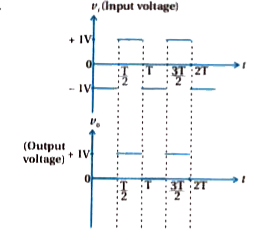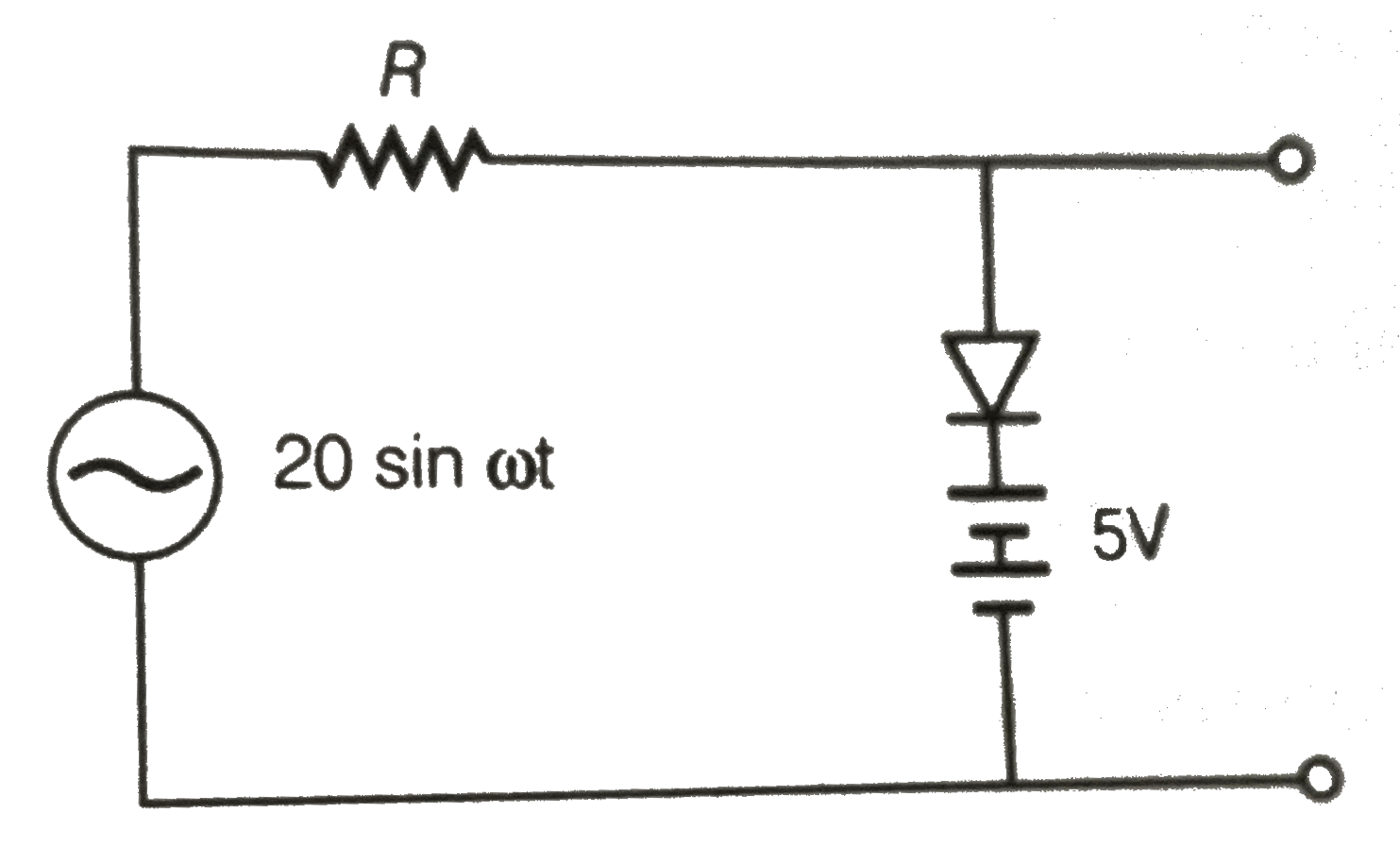
Draw the output waveform across the resistor. Solution in Gujrati

Here, current passing through the closed path given in the statement,
I=viR+RD …(1)
(where RD= resistance of diode)
During negative half cycle of input voltage, since diode is reverse biased, RD=∞ and so from equation (1), I = 0 and so output voltage
v0=IR=0 (∵I=0)
During positive half cycle of input voltage, since diode is forward biased , RD=0 and so from equation (1), I=viR and so output voltage v0=IR=(viR)R=vi=1 volt. (from figure)
Topper's Solved these Questions
- SEMICONDUCTOR ELECTRONICS : MATERIALS, DEVICES AND SIMPLE CIRCUITS BOOK - KUMAR PRAKASHANCHAPTER - SEMICONDUCTOR ELECTRONICS : MATERIALS, DEVICES AND SIMPLE CIRCUITS EXERCISE - Section-C: NCERT Exemplar Solution (Short Answer Type Questions)
8 Videos
- SEMICONDUCTOR ELECTRONICS : MATERIALS, DEVICES AND SIMPLE CIRCUITS BOOK - KUMAR PRAKASHANCHAPTER - SEMICONDUCTOR ELECTRONICS : MATERIALS, DEVICES AND SIMPLE CIRCUITS EXERCISE - Section-C: NCERT Exemplar Solution (Long Answer Type Questions)
10 Videos
- SEMICONDUCTOR ELECTRONICS : MATERIALS, DEVICES AND SIMPLE CIRCUITS BOOK - KUMAR PRAKASHANCHAPTER - SEMICONDUCTOR ELECTRONICS : MATERIALS, DEVICES AND SIMPLE CIRCUITS EXERCISE - Section-C: NCERT Exemplar Solution (Multiple Choice Qustion (More than One Options))
8 Videos
- SAMPLE QUESTION PAPER BOOK - KUMAR PRAKASHANCHAPTER - SAMPLE QUESTION PAPER EXERCISE - PART-B SECTION-C
5 Videos
- WAVE OPTICSBOOK - KUMAR PRAKASHANCHAPTER - WAVE OPTICSEXERCISE - SECTION-D (MULTIPLCE CHOICE QUESTIONS (MCQS)) (MCQS FROM DARPAN BASED ON TEXTBOOK)
239 Videos
Similar Questions

(i) Name the type of a diode whose characteristics are shown in figure (1) and figure (2).
(ii) What does the point P in figure (1) represent?
(iii) What does the points P and Q in figure (2) represent?
View Solution
If each diode in figure has a forward bias resistance of 25Ω and infinite resistance in reverse bias, what will be the values of the current I1,I2,I3andI4?
View SolutionWhen an electric field is applied across a semiconductor
View SolutionTwo charges –q and +q are located at points (0, 0, –a) and (0, 0, a), respectively.
(a) What is the electrostatic potential at the points (0, 0, z) and (x, y, 0) ?
(b) Obtain the dependence of potential on the distance r of a point from the origin when r/a>>1 .
(c) How much work is done in moving a small test charge from the point (5,0,0) to (–7,0,0) along the x-axis? Does the answer change if the path of the test charge between the same points is not along the x-axis?
View SolutionAccording to particle theory of light what is the velocity of light in a dense medium, compared to that in rare medium ?
View SolutionDraw and explain the output waveform across the load resistor R, if the input wave from is as shown in Fig.

View SolutionDraw the output waveform across the resistor (Fig.)
View SolutionAssuming the ideal diode, draw the output waveform for the circuit given in Fig.Explain the waveform.

View SolutionWhat is an ideal diode ? Draw the output waveform across the load resistor R, If the wavelength is as shown in the figure.
View SolutionAssuming the ideal diode, draw the output waveform for the circuit given in fig. (a), explain the waveform

View SolutionDraw the output waveform of a full wave rectifier.
View Solutionप्रतिरोध के सिरों के बीच निर्गत तरंगरूप बनाइए|

View SolutionDraw the output waveform of a full wave rectifier.
View SolutionDraw the output waveform of a full wave rectifier.
View SolutionDraw the output wave form across the resistor

View Solution
